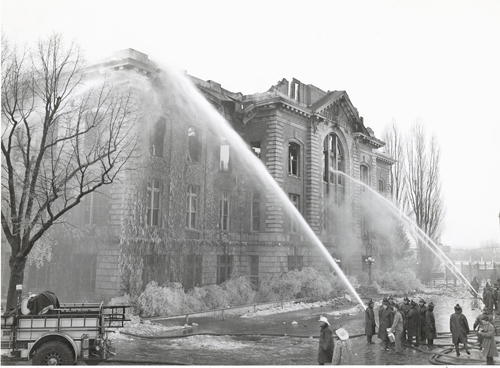
On January 11th 1937, an explosion was heard in one of the labs in Lyman Hall and soon after a fire was reported on the building’s fourth floor which damaged the roof of the building. It was believed that an unattended gas burner started the blaze. The University’s Museum of Natural History was lost in the fire, as well as numerous records and research materials. Fortunately, repairs were completed quickly and the building was reopened later that year.
According to the Syracuse University Archives, “Originally occupied by the Departments of Biology, Botany, Geology, Zoology, Psychology and Geography, in 1930 the fourth floor was remodeled and made into the Natural History Museum bringing together the various museum collections previously distributed throughout the building…fire damage was estimated at $79,000. By the start of February, the building was once again open for classes; it was completely restored by September of 1937. In 2009, two floors were remodeled to house the JP Morgan Chase Technology Center, an on-campus facility where students and faculty partner with bank employees to conduct research and run global technology operations.”
Ten years later, on January 12th 1947, a fire destroyed most of Archbold Gymnasium. This fire was more devastating than the one at Lyman Hall, and it took several years to completely rebuild the structure.
According to the Syracuse University Archives, “In 1907 the Trustees agreed to erect a gymnasium at a cost of $200,000 with the money to be raised by placing a mortgage on the University Block. The cost was soon revised to $300,000. The cornerstone laying took place on March 24, 1908, and the gym was officially opened on December 17, 1908 with the Junior Prom. The first classes were held in the new gym on March 1, 1909. In June 1909 John D. Archbold gave the University $300,000 to cancel the mortgage on the University Block.
The gymnasium building measured 150′ by 210′ with the gymnasium room measuring 100′ by 205′. It contained a swimming pool, rowing tank, baseball cage, and an indoor track measuring twelve laps to the mile. Bowling alleys were installed in the fall of 1911 through the generosity of John D. Archbold.
After the fire, most of the old superstructure still standing was demolished, except for the north wing, the least damaged in the blaze. The north wing was reconstructed and remodeled starting in the spring of 1948. By February 1949 the Athletic Department returned to the building. The reconstructed rear section was not completed until 1952.
In October 1989, the building’s locker rooms, stairways and exit controls were renovated concordant with the opening of neighboring Flanagan Gym. Archbold connected to Flanagan via 110′ glass-enclosed bridge.”
“

